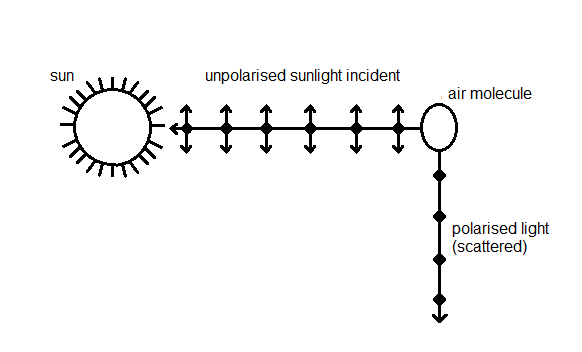
Answer
459.9k+ views
Hint: Light propagates as transverse electromagnetic waves. The magnitude of the electric field is much larger as compared to the magnitude of the magnetic field. We generally prefer to describe light as electric field oscillations.
Complete step by step answer:
(a) Light is an electromagnetic wave emitted by the sun. An electromagnetic wave is a transverse wave and consists of oscillations of electric and magnetic fields perpendicular to propagation of the wave.
Ordinary light has oscillations in all directions. This light is called an unpolarised light. When the oscillations are in a single plane, the light is called linearly polarised light.
Sunlight is an unpolarised light. When it travels through the earth’s atmosphere, due the tiny particles present, it undergoes scattering. Due to scattering of sunlight polarised and partially polarised light is formed. The polarised light is in the direction perpendicular to the propagation of the original unpolarised light.
The given diagram shows the process of polarisation of sunlight. The dots and double arrows are any two perpendicular planes of oscillations of electric field.

(b) When an unpolarised light passes through a polariser, the intensity of the transmitted polarised light reduces to half of the intensity of polarised light. It does not matter on the angle between the transmission axis and the plane of polarisation. Therefore, even when the polariser is rotated the intensity of the transmitted light becomes half.
Note: Malus law states that the intensity of the polarised light transmitted through the analyser varies as the square of the cosine of the angle between the plane of transmission of the analyser and the plane of the polariser.
Complete step by step answer:
(a) Light is an electromagnetic wave emitted by the sun. An electromagnetic wave is a transverse wave and consists of oscillations of electric and magnetic fields perpendicular to propagation of the wave.
Ordinary light has oscillations in all directions. This light is called an unpolarised light. When the oscillations are in a single plane, the light is called linearly polarised light.
Sunlight is an unpolarised light. When it travels through the earth’s atmosphere, due the tiny particles present, it undergoes scattering. Due to scattering of sunlight polarised and partially polarised light is formed. The polarised light is in the direction perpendicular to the propagation of the original unpolarised light.
The given diagram shows the process of polarisation of sunlight. The dots and double arrows are any two perpendicular planes of oscillations of electric field.

(b) When an unpolarised light passes through a polariser, the intensity of the transmitted polarised light reduces to half of the intensity of polarised light. It does not matter on the angle between the transmission axis and the plane of polarisation. Therefore, even when the polariser is rotated the intensity of the transmitted light becomes half.
Note: Malus law states that the intensity of the polarised light transmitted through the analyser varies as the square of the cosine of the angle between the plane of transmission of the analyser and the plane of the polariser.
Recently Updated Pages
what is the correct chronological order of the following class 10 social science CBSE

Which of the following was not the actual cause for class 10 social science CBSE

Which of the following statements is not correct A class 10 social science CBSE

Which of the following leaders was not present in the class 10 social science CBSE

Garampani Sanctuary is located at A Diphu Assam B Gangtok class 10 social science CBSE

Which one of the following places is not covered by class 10 social science CBSE

Trending doubts
Which are the Top 10 Largest Countries of the World?

What percentage of the solar systems mass is found class 8 physics CBSE

Fill the blanks with the suitable prepositions 1 The class 9 english CBSE

The Equation xxx + 2 is Satisfied when x is Equal to Class 10 Maths

How do you graph the function fx 4x class 9 maths CBSE

Give 10 examples for herbs , shrubs , climbers , creepers

Difference Between Plant Cell and Animal Cell

Why is there a time difference of about 5 hours between class 10 social science CBSE

Difference between Prokaryotic cell and Eukaryotic class 11 biology CBSE



